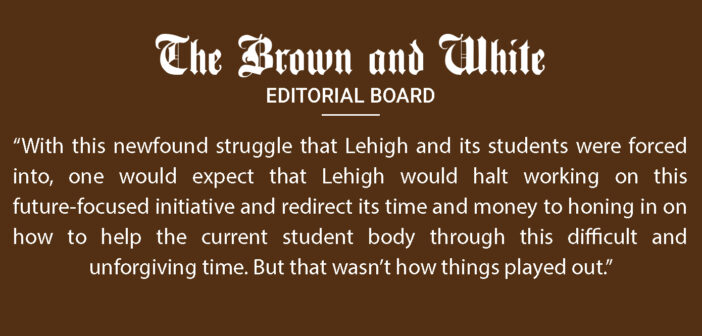Back in 2015, President John Simon and the Lehigh Board of Trustees announced “The Path to Prominence,” an initiative with the focus on three main goals: expansion, evolution and exploration.
This multifaceted plan was formally approved by the board in 2016 and, from there, Lehigh planned to expand the school’s student body and faculty, upgrade facilities, build new residential communities and academic buildings and launch a new college focused on health.
Among the most significant changes through this plan between, 2016 and 2019, were the $31 million renovation to the Chandler-Ulman building, the beginning of construction to the new College of Health, the $1 billion fundraising and engagement effort and the $20 million gift to renovate Lehigh’s University center through “GO: The Campaign for Lehigh.”
Enter COVID-19.
Amid the pandemic, the entire world was sent into survival mode. Millions of individuals lost their jobs and homes, small businesses were forced to close their doors and students and other workers were sent home to complete their educations and jobs in virtual settings.
It was a year of struggle, change and constant adaptation.
With this newfound struggle that Lehigh and its students were forced into, one would expect that Lehigh would halt working on this future-focused initiative and redirect its time and money to honing in on how to help the current student body through this difficult and unforgiving time.
But that wasn’t how things played out.
Rather, the Path to Prominence took precedent and kept running full speed ahead, while the student body and faculty were left to fend for themselves, much like they had already been during “precedented” times.
Many professors at Lehigh lost their jobs or were furloughed, and Lehigh only offered a 10 percent decrease in tuition for students who chose to not have access to campus facilities. All the while, funds were continuously funnelled into the construction of the College of Health and the new dormitories throughout the pandemic.
The introduction of the College of Health and the new dormitories were planned in tandem with introducing a freshman class of an additional 1,000 students, with the overall goal of increasing Lehigh’s prestige and competitiveness.
However, the last two classes saw a dramatic increase in acceptance rates and smaller applicant pool compared to years past.
Lehigh’s acceptance rate usually landed somewhere in the 20s, but in 2024 with about 12,400 applicants we accepted 49.5 percent. And in 2025, despite the increase in applicants by almost 2,000, the acceptance rate remained high at 45 percent.
Lehigh administration is so focused on achieving a heightened reputation that they almost seem as if they forget that it’s not only the programs that give a school the name of a prestigious institution, but also its students and professors.
The introduction of the College of Health is important because it expands the breadth of education offered at Lehigh, but it’s a bad allocation of funds when there is minimal investment into the other programs at Lehigh that are struggling.
The College of Arts & Sciences, for example, holds one-third of the school’s population, yet students in this college are met with significantly less undergraduate and postgraduate opportunities than those in the business and engineering schools. Programs within the CAS do not have as much depth or breadth within courses and faculty as the other undergraduate colleges do.
Perhaps to Lehigh, it seems useless to invest into a college that Lehigh isn’t particularly “known for,” but that doesn’t mean the students in this college are any less worth investing in.
The Path to Prominence has continuously created a negative atmosphere for current students here at Lehigh, and is the reason Lehigh is losing its reputation.
Investing in the future is useless if those plans don’t include investing in the current student body that will make Lehigh better in the future.
Current students play an extremely influential role in prospective students’ decision on whether to attend a certain school or not—they want to hear about their on-the-ground experiences to gauge whether it would be a good fit for them outside of what the admissions marketing tells them.
While the programs that a university offers are also extremely integral in this decision, if a current student doesn’t speak highly of a school, odds are, that prospective student won’t think highly of it either.
President Simon has taken us on a detour from the Path to Prominence onto the road to failure. His departure from Lehigh validates many of the qualms the student body has held in recent years. Hopefully our administration’s next leader will be able to set us back on track, most importantly by prioritizing current students, not just reputation and growth.






Comment policy
Comments posted to The Brown and White website are reviewed by a moderator before being approved. Incendiary speech or harassing language, including comments targeted at individuals, may be deemed unacceptable and not published. Spam and other soliciting will also be declined.
The Brown and White also reserves the right to not publish entirely anonymous comments.
2 Comments
“The College of Arts & Sciences, for example, holds one-third of the school’s population, yet students in this college are met with significantly less undergraduate and postgraduate opportunities than those in the business and engineering schools. Programs within the CAS do not have as much depth or breadth within courses and faculty as the other undergraduate colleges do.”
“The introduction of the College of Health is important because it expands the breadth of education offered at Lehigh, but it’s a bad allocation of funds when there is minimal investment into the other programs at Lehigh that are struggling.”
The first quote seems to be factual, the second quote seems to be a conjecture and needs to be discussed. The question “why?” could be asked for both quotes.
Why would you pay, price discussed by B&W elsewhere, for a Lehigh Education; see quote one. Why College of Health? LU is betting that it will resemble Business and Engineering more than Arts & Sciences.
This is not disparaging The College of Arts & Sciences (CAS) to which most of the staff at The Brown and White (B&W) owe allegiance. The B&W does excellent work. I have confidence that the education that other CAS students receive is also excellent.
The size of the University is a question for me. At what point do students lose contact with each other such that a mixing from the various colleges is impeded. My Lehigh had organic mixing, current Lehigh seems to have educationally driven mixing. Is current mixing driven by organization membership? Is there mixing.
How many today are involved in Lehigh and how many are just at Lehigh.
I disagree with the sentiment that Lehigh does not pay enough attention to CAS. Lehigh was built on and continues to be known for occupational education like engineering and business. The primary focus for Lehigh, for the time being, should be reinvesting in it’s successful programs. Now that doesn’t mean ignore the college of arts and sciences. Journalism in particular is quite successful for Lehigh and should be taken more seriously, but not every major in CAS is like that. The business school and engineering school on the other hand are successful in nearly all programs. To truly raise the prominence of the university Lehigh needs to push what it’s know for until it’s one of the best for it. Then Lehigh can diversify.